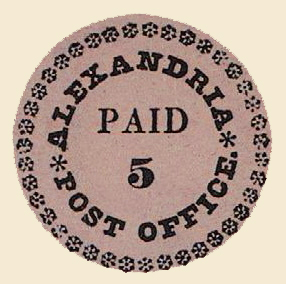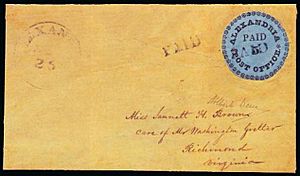Alexandria "Blue Boy" Postmaster's Provisional facts for kids
Quick facts for kids Alexandria "Blue Boy" |
|
|---|---|

Alexandria "Blue Boy" stamp
|
|
| Country of production | United States of America |
| Location of production | Alexandria, Va. |
| Date of production | 1847 |
| Nature of rarity | Unique |
| No. in existence | One |
| Face value | 5 cents |
| Estimated value | $1,000,000 (in 1981) |
The Alexandria "Blue Boy" is a super rare postage stamp. It's called "Blue Boy" because of its special blue color. This stamp is one of only seven known "Postmaster's Provisionals" from Alexandria, Virginia. These stamps were made starting in 1846. The "Blue Boy" is the only one printed on blue paper. The other six are on a light brown paper.
The "Blue Boy" stamp is still stuck to the original envelope it was mailed on. This envelope was sold in 2019. It holds the record for the most expensive "cover" (an envelope with a stamp) in United States stamp collecting history.
Why Were Provisional Stamps Made?
Before July 1, 1847, the United States did not have its own national postage stamps. So, some cities made their own local stamps. This allowed people to pay for their mail before sending it. Alexandria was one of eleven cities that did this. These local stamps were called "provisional stamps."
Even after the national stamps came out, some cities still used their provisional stamps for a short time. The "Blue Boy" is an example of this. During the time Alexandria made these stamps, the city was changing. It was moving from being part of the District of Columbia back to the state of Virginia. This change was finished on March 13, 1847.
How the Stamps Were Made
The Alexandria provisional stamps were made under the direction of the city's postmaster, Daniel Bryan. No one knows for sure who printed them. But experts think they were likely made using equipment from a local newspaper. This newspaper was called the Alexandria Gazette. It was published by Edgar Snowden.
The stamps were printed two at a time. They were made from a special printing plate that created two slightly different images. Stamp experts call these Type I and Type II. The "Blue Boy" is one of four Type I stamps that still exist. Only three Type II stamps are known.
Both types of stamps have a round design. They have an outer ring of small flower-like shapes called rosettes. Inside that, there's a smaller ring of text that says "ALEXANDRIA "* POST OFFICE. *". In the middle of the stamp, it says "PAID" with the number "5" below it. The main difference is that Type I stamps have 40 rosettes. Type II stamps only have 39 rosettes. Also, the letters and asterisks are spaced differently on Type II stamps.
The Famous Envelope
The only "Blue Boy" stamp still exists on the yellowish envelope it was mailed on. The stamp has a "PAID" mark on it, showing it was used. In 1981, a collector from Germany bought it for one million dollars.
In 2019, the "Blue Boy" was sold again. It fetched $1.18 million, which is about $1.2 million!
The "Blue Boy" is famous not just for its value. It also has a romantic story connected to it. This story was even shared in The Washington Post newspaper. The "Blue Boy" stamp was used to mail a secret letter. It was written by James Wallace Hoof on November 24, 1847. He sent it to his second cousin, Janette H. Brown. James was trying to win Janette's heart, but her family did not approve.
The stamp almost got destroyed! At the end of his letter, James wrote "Burn as usual." This meant Janette should burn the letter after reading it. Luckily, she didn't! James and Janette had to wait almost six years to get married. They finally tied the knot on February 17, 1853.
At some point, Janette put the letter into her sewing box. It stayed hidden there until 1907. That's when her daughter, also named Janette, found it. Later that year, a stamp collector bought the envelope for $3,000. At that time, only three other Alexandria provisional stamps were known. The letter itself stayed with the family.
Some people debate if the "Blue Boy" should be in the same super-rare group as stamps like the Treskilling Yellow from Sweden. This is because the "Blue Boy" was a local, provisional stamp, not a regular national one. But it's still incredibly special!
See also
 In Spanish: Blue Boy (filatelia) para niños
In Spanish: Blue Boy (filatelia) para niños



